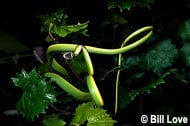Description:
The terrarium for this arboreal snake should be vertical and well-ventilated. Try using a mesh cage (usually sold for chameleons) or turn a 20-gallon aquarium on end and use a mesh lid for the front of the terrarium. Rough green snakes drink droplets of water from leaves and branches and typically will not drink from a dish. The terrarium should have a variety of large-leaved plants and vines (live or artificial) that are misted daily with clean water. Use aspen or a similar moisture-absorbing bedding for substrate. An average temperature of 80 to 85 degrees Fahrenheit, dropping a few degrees at night, works well. A small basking lamp can be used to heat part of the terrarium to 90 to 95 degrees for a few hours a day. In nature, rough green snakes feed on a variety of soft-bodied invertebrates, especially moth and butterfly caterpillars. Living food is essential. In the terrarium they will take crickets and waxworms, as well as wild-caught insects and larvae from areas that have not been treated with pesticides or herbicides. This snake needs many small meals rather than a few large meals, so feed at least every other day. Insects should be dusted with a calcium and vitamin supplement powder several times a week.
Habitat:
The slender, whip-like body shape shows this species to be arboreal, both basking and hunting for prey in shrubs and trees. It prefers moist areas, but also is found along wooded pasture edges. Specimens are active both during the day and at night.
Range:
Widely distributed from southern New Jersey to Kansas, over the entire southern U.S. to central Texas and also in northeastern Mexico.
Scientific Name: Opheodrys aestivus
Species Group:
Family: Colubridae
Size: 20 to 30 inches
Level: intermediate
Weight:
Dangerous: No


